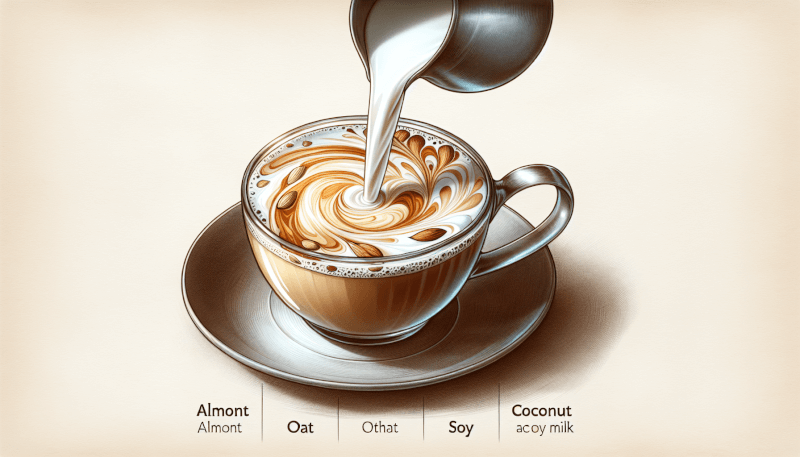Do you love a warm and frothy tea latte but find yourself wanting to try something new? Look no further! In this article, we will be exploring a variety of milk alternatives to elevate your tea latte experience. From creamy oat milk to the smoothness of almond milk and the richness of coconut milk, we will uncover the perfect milk alternative that will complement your favorite tea to create the most delicious and satisfying tea latte. Get ready to embark on a delightful journey of flavors and find your new go-to milk alternative for your perfect tea latte.

1. Introduction
If you’re looking to switch out traditional cow’s milk for an alternative, you’re in luck! There are now countless milk alternatives available on the market, offering a variety of benefits and flavors. Whether you’re lactose intolerant, watching your calories, or following a vegan lifestyle, there’s a milk alternative out there for you. In this article, we’ll explore the benefits of milk alternatives and help you choose the right one for your needs. Plus, we’ll dive into the specific taste, frothing abilities, and nutritional information of popular milk alternatives such as almond, oat, soy, coconut, rice, hemp, and macadamia nut milk. So, let’s get started on this deliciously informative journey!

2. Benefits of Milk Alternatives
2.1. Lactose-free options
One of the primary benefits of milk alternatives is that they provide lactose-free options for individuals who are lactose intolerant. Lactose, a sugar found in milk, can cause digestive discomfort for some people. By opting for milk alternatives like almond, oat, soy, or coconut milk, you can enjoy a creamy beverage without the unpleasant side effects of lactose intolerance.
2.2. Lower in calories
For those mindful of their calorie intake, milk alternatives are often lower in calories compared to cow’s milk. This can be particularly beneficial if you’re trying to manage or lose weight. Almond milk, for example, typically contains fewer calories than whole milk, making it a popular choice for those looking to reduce their calorie intake without sacrificing the taste and texture of their favorite beverages.
2.3. Vegan and cruelty-free choices
If you follow a vegan lifestyle or want to make more sustainable choices, milk alternatives offer vegan and cruelty-free options. Unlike cow’s milk, which requires the use of animals and can contribute to environmental issues, plant-based milk alternatives like oat, soy, and coconut milk offer a more sustainable and ethically conscious alternative. By choosing milk alternatives, you can enjoy your favorite beverages while aligning with your values.
2.4. Nutritional advantages
Milk alternatives also come with their own unique nutritional advantages. While they may not contain the same levels of certain nutrients as cow’s milk, they often provide essential vitamins and minerals. For instance, almond milk is a good source of vitamin E, soy milk is high in protein, and oat milk is rich in fiber. By varying your milk alternatives, you can add a diverse range of nutrients to your diet.

3. Choosing the Right Milk Alternative
When it comes to choosing the right milk alternative, there are a few factors you should consider to ensure it suits your taste preferences and specific needs. Here are some key points to consider:
3.1. Consider the flavor
Different milk alternatives have distinct flavors that can complement or enhance your beverages. Almond milk has a slightly nutty flavor, while oat milk offers a creamy and slightly sweet taste. Soy milk has a more neutral taste, allowing the flavors of other ingredients to shine. Coconut milk lends a tropical and rich undertone, while rice milk has a naturally sweet flavor. Hemp milk has a nutty taste, and macadamia nut milk is known for its creamy and buttery flavor. Consider your personal flavor preferences when making your selection.
3.2. Frothing capabilities
If you enjoy lattes or other frothy drinks, it’s essential to choose a milk alternative that can be successfully frothed. Some milk alternatives, like almond and oat milk, froth exceptionally well, allowing you to create beautifully textured beverages. Soy milk also froths relatively easily, making it a popular choice for coffeehouse-style drinks. On the other hand, coconut, rice, hemp, and macadamia nut milk may not froth as readily due to their unique compositions. Consider your frothing needs when selecting a milk alternative.
3.3. Allergies and intolerances
It’s crucial to consider any allergies or intolerances you may have when choosing a milk alternative. While milk alternatives are generally free from common allergens like dairy, lactose, and nuts, certain brands may process their products in facilities that handle allergens. It’s always recommended to carefully read labels or opt for certified allergen-free milk alternatives if you have specific dietary restrictions.
3.4. Nutritional profile
Each milk alternative has its own nutritional profile, and it’s important to consider this when making your selection. Some milk alternatives, like soy milk, offer a similar protein content to cow’s milk, making them suitable for individuals looking to boost their protein intake. Others, like almond milk, may provide additional vitamins and minerals. Take into account your dietary needs and the nutrients you want to incorporate into your diet.

4. Almond Milk
4.1. Taste and flavor notes
Almond milk is renowned for its subtly nutty flavor. It has a delicate and slightly sweet taste, which blends well with various beverages, including tea lattes. The nuttiness adds a pleasant depth to the drinks without overpowering the desired flavors.
4.2. Frothing ability
Almond milk is excellent for frothing and creating microfoam, making it a popular choice for latte art enthusiasts. Its unique composition allows it to create creamy and velvety textures, adding a luxurious touch to your beverages.
4.3. Nutritional information
Almond milk is relatively low in calories compared to cow’s milk, making it an attractive option for those watching their calorie intake. It is also naturally lactose-free and commonly fortified with calcium and vitamin D. However, it is lower in protein than cow’s milk, so individuals with higher protein needs may need to ensure other sources in their diet.
(Body of article continues…)



